
Rabat is a town in the Northern Region of Malta, with a population of 11,497 as of March 2014. It adjoins the ancient capital city of Mdina, and a north-western area formed part of the Roman city of Melite until its medieval retrenchment.

António Manoel de Vilhena was a Portuguese nobleman who was the 66th Prince and Grand Master of the Order of St. John of Jerusalem from 19 June 1722 to his death in 1736. Unlike a number of the other Grand Masters, he was benevolent and popular with the Maltese people. Vilhena is mostly remembered for the founding of Floriana, the construction of Fort Manoel and the Manoel Theatre, and the renovation of the city of Mdina.
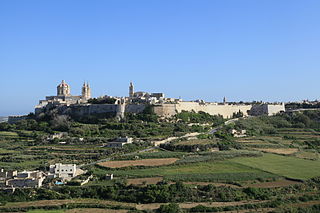
Mdina, also known by its Italian epithets Città Vecchia and Città Notabile, is a fortified city in the Northern Region of Malta which served as the island's former capital, from antiquity to the medieval period. The city is still confined within its walls, and has a population of 250, but it is contiguous with the town of Rabat, which takes its name from the Arabic word for suburb, and has a population of over 11,000.
Charles François de Mondion was a French architect and military engineer who was active in Hospitaller Malta in the early 18th century. He was also a member of the Order of Saint John.

Maltese architecture has its origins in prehistory, and some of the oldest free-standing structures on Earth – a series of megalithic temples – can be found on Malta. The islands were colonized by the Phoenicians and later the Romans, who established the cities of Melite and Gaulos. Although these were substantial settlements and are known to have had numerous temples, churches and palaces, few remains have survived apart from some architectural fragments.
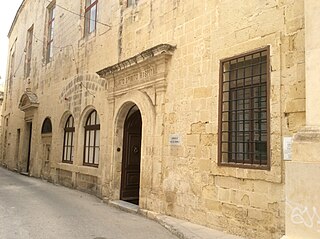
The National Archives of Malta is the central archive maintained by the Mediterranean island nation of Malta. The Archives has been housed in the Grandmaster's Palace for most of its lifetime, having moved to three separate locations during the late 1980s. In 1988, the Legal Documentation Section of the National Archives of Malta was opened, after records of court and tribunal hearings and decisions had been transferred to a Mdina facility beginning the previous year. A Gozo facility was opened soon after, and in 1994, the then-President of Malta, Ugo Mifsud Bonnici, officially opened the Archives' new head office and main facility at the former Santo Spirito Hospital in Rabat. All of the Archives' locations feature a reading room, with facilities for researchers open to those over the age of sixteen who produce valid identification.

The Collegium Melitense was a Jesuit college in Valletta, Hospitaller Malta, which existed between 1592 and 1769. Lectures at the educational institution began in 1593, and it moved to a purpose-built building adjacent to a Jesuit church in 1597. The 17th century saw an expansion of its curriculum and an increase in the number of students in the college, and in 1727 it was recognised as a university and subsequently it also became known as the Academia Parthenia. After the Jesuits were suppressed from Malta, the college was reorganised into the Pubblica Università di Studi Generali, which was established on 22 November 1769. The latter is now known as the University of Malta.

Hospitaller Malta, known in Maltese history as the Knights' Period, was a de facto state which existed between 1530 and 1798 when the Mediterranean islands of Malta and Gozo were ruled by the Order of St. John of Jerusalem. It was formally a vassal state of the Kingdom of Sicily, and it came into being when Emperor Charles V granted the islands as well as the city of Tripoli in modern Libya to the Order, following the latter's loss of Rhodes in 1522. Hospitaller Tripoli was lost to the Ottoman Empire in 1551, but an Ottoman attempt to take Malta in 1565 failed.

Vilhena Palace, also known as the Magisterial Palace and Palazzo Pretorio, is a French Baroque palace in Mdina, Malta. It is named after António Manoel de Vilhena, the Grand Master who commissioned it. It was built between 1726 and 1728 to designs of the French architect Charles François de Mondion, on the site of the meeting place of the Università. The palace was used a hospital in the 19th and 20th centuries, and it became known as Connaught Hospital after 1909. Since 1973, it has been open to the public as Malta's National Museum of Natural History.

The fortifications of Mdina are a series of defensive walls which surround Mdina, the former capital city of Malta from antiquity to the medieval period. The city was founded as Maleth by the Phoenicians in around the 8th century BC, and it later became part of the Roman Empire under the name Melite. The ancient city was surrounded by walls, but very few remains of these have survived.
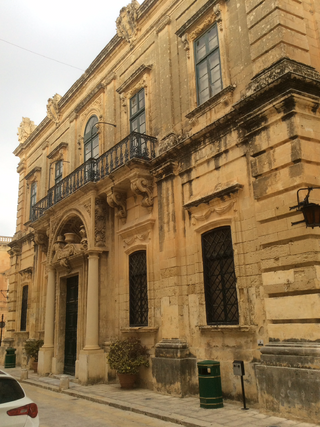
The Banca Giuratale, also known as the Municipal Palace, is a public building in Mdina, Malta. It was built in the 18th century to house the city's administrative council and courts, and was later used as a private residence and a school. It now houses part of the National Archives of Malta.

The Corte Capitanale is a former courthouse in Mdina, Malta, which currently serves as a city hall. It was built in the Baroque style between 1726 and 1728, to designs of the French architect Charles François de Mondion. The building is linked to Palazzo Vilhena, but it has its own entrance and façade.
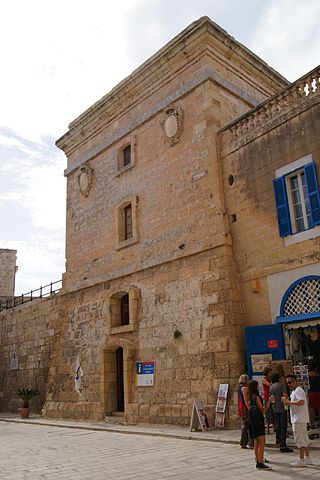
The Torre dello Standardo is a tower in Mdina, Malta, forming part of the city's fortifications. It was built by the Order of St. John between 1725 and 1726, on the site of an earlier tower, and its purpose was to communicate signals between Mdina and the rest of Malta. Today, the tower is in good condition, and it serves as a tourist information centre and for occasional cultural events.

Mdina Gate, also known as the Main Gate or the Vilhena Gate, is the main gate into the fortified city of Mdina, Malta. It was built in the Baroque style in 1724 to designs of Charles François de Mondion, during the magistracy of Grand Master António Manoel de Vilhena.

Melite or Melita (Latin) was an ancient city located on the site of present-day Mdina and Rabat, Malta. It started out as a Bronze Age settlement, which developed into a city called Ann under the Phoenicians and became the administrative centre of the island. The city fell to the Roman Republic in 218 BC, and it remained part of the Roman and later the Byzantine Empire until 870 AD, when it was captured and destroyed by the Aghlabids. The city was then rebuilt and renamed Medina, giving rise to the present name Mdina. It remained Malta's capital city until 1530.
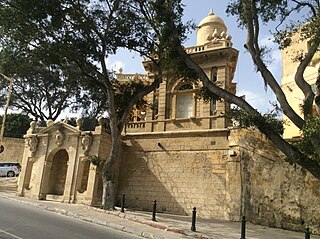
Saqqajja is an urban area within the administration of Mdina, Malta, outside the walled city.
Pietro Paolo Troisi was a Maltese Baroque silversmith, sculptor, medallist, designer, engraver and Master of the Mint. His works include bronze sculptures of his patron António Manoel de Vilhena, designs of various coins and medals, a wide range of mainly religious works in silver, engraved portraits, designs for temporary triumphal arches and designs for works in a number of churches, most notably the altar of repose at the Mdina cathedral.

Grand Master Philippe Villiers de l'Isle Adam Taking Possession of Mdina is a painting by the French artist Antoine de Favray from c. 1750. It depicts Philippe Villiers de L'Isle-Adam, a Grand Master of the Knights Hospitaller, entering the city of Mdina and taking possession of it in a ceremony known as the possesso. The real-life event which is the subject of the painting took place on 13 November 1530, shortly after the establishment of Hospitaller rule in Malta. The painting is an iconic representation of Hospitaller Malta, and it is located within the Grandmaster's Palace in Valletta, Malta.

The Mdina Cathedral Museum is a religious art museum located inside the mediaeval walled city of Mdina, Malta. The museum is housed within a Baroque building that was built as a Jesuit seminary. It can be found on the right-hand side of the St. Paul's Cathedral, in Archbishop's Square. The museum's collection includes an eclectic secular and ecclesiastical repertoire. The museum also holds various artwork and archaeology remains, including important artwork by Mattia Preti. The museum also owns the most important collection of Italian Baroque music that has been preserved south of Naples.



















